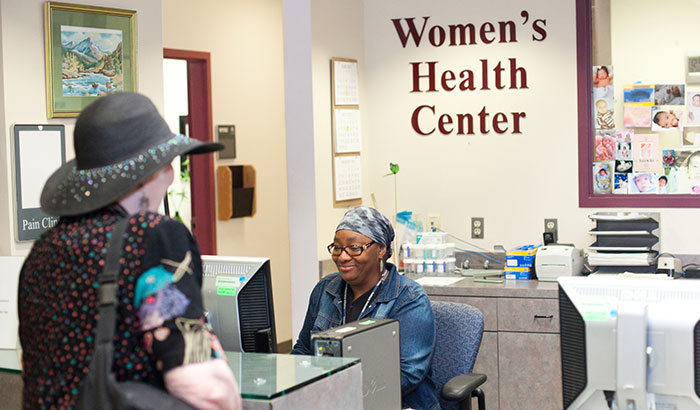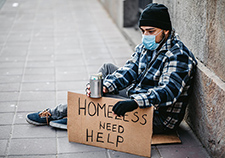Office of Research & Development |
 |


VA’s health care services for women Veterans include special programs for homeless women Veterans. Shown here is the women’s health center at the VA Greater Los Angeles Healthcare System. (Photo by Nathan Morgan)
March 21, 2018
By Mike Richman
VA Research Communications
Rehabilitating homeless female Vets through 'mind, body, spirit'
It's a holistic form of trauma rehabilitation.
Staff members take that approach at a transitional facility for homeless female Veterans on the campus of the VA Central Western Massachusetts Healthcare System.
Ashley Martel was caught in a dangerous web. Her life was spiraling out of control, and she had nowhere to turn.
The Army Veteran was arrested for driving under the influence of drugs and spent time in jail for violating probation and driving on a suspended license. She also suffered from PTSD largely due to a traumatic experience while she served in the Army from 2009 to 2010.
Having reached a breaking point, she attempted suicide by overdosing on pain medication before going to sleep one night. She woke up a few hours later and cried.
“I’ve been struggling with depression for years,” says Martel, now 29. “In the past year, I wanted to die. I didn’t have any purpose. I was dancing. I was seeing the ugly. The military made me hate men. I was just consumed with sadness. I couldn’t get a grip on anything.”


The images show artwork by Ashley Martel that she created in art therapy groups at Soldier On. (Photos by Casey DiCicco/Soldier On)
Although Martel always had a roof over her head, her housing situation was unstable. She was broke, couldn’t pay her rent, and lacked electricity and hot water for up to eight months. She’s now living in a transitional housing facility that rehabilitates homeless female Veterans on the VA campus in Leeds, Massachusetts, where she says she has found “structure.”
Martel is fortunate that her life has stabilized. Many other female Vets aren’t as lucky.
Women comprise the fastest-growing segment of the homeless Veteran population. In its 2017 Annual Homeless Assessment Report to Congress, the U.S. Department of Housing and Urban Development (HUD) estimated that just over 40,000 veterans were homeless on a single night in January of that year. Of those, about 9 percent were women, out of a population of more than 2 million female Veterans. From 2016 to 2017, the number of homeless female Vets increased by 7 percent, compared with 1 percent for their male counterparts.
In a 2016 report, the VA-funded National Center on Homelessness Among Veterans said the number of women identified by the program as homeless, or who accessed VA programs to end homelessness among female Vets, tripled to 36,443 in a five-year period ending in 2015. That figure, according to the center, is projected to rise by about 9 percent to nearly 40,000 by 2025.
The center noted that the increases are partly due to the expansion of VA homeless programs. In addition, it said, the VA data “only capture women who use the VA health system, and therefore [the data] miss an unknown proportion of Veterans who may use only community-based homeless assistance programs.”
"Women Veterans have been overrepresented among the homeless population."
That unknown figure is a “huge segment of the homeless population that is flying under the radar,” says Stephanie Ovitt, the wellness director at Soldier On, which provides homeless Veterans with transitional housing and support services. Soldier On owns the facility where Martel is staying at the VA Central Western Massachusetts Healthcare System .
“We see a number of women who do not wish to access VA services and therefore are not in the system,” says Ovitt, who is also a case manager for the women’s program at Soldier On. “Due to such a high number of women being victims of military sexual trauma, many feel resentment toward the military and often do not associate themselves with being a Veteran.”
Military sexual trauma, or MST, is the term VA uses for sexual assault or repeated, threatening sexual harassment experienced during military service. According to VA’s National Center for PTSD, data from VA’s MST screening program show that about 1 in 4 women and 1 in 100 men respond "yes," that they experienced MST, when screened by their VA provider. NCPTSD emphasizes that these data speak only to the rate of MST among Veterans seeking VA care, and do not necessarily reflect the rate among all Veterans.
According to HUD, someone who lacks a “fixed, regular, and adequate” nighttime residence meets the criteria for homelessness. A person with a primary nighttime residence that is not designed for regular sleeping, such as a car or abandoned building, also fits the definition.

Photos shed light on food insecurity in post 9/11 Veterans

Homeless Veterans largely satisfied with community health care options
Various VA initiatives, including job, educational, and housing opportunities, have helped fuel a precipitous decline in the number of former U.S. service members who are homeless—a 47 percent overall reduction between 2010 and 2016.
For much of the past decade, VA eyed a goal of zero homeless Veterans. But VA Secretary David Shulkin backed off that target last year, saying he’s focused on cutting the number of homeless Vets from 40,000 to below 15,000.
In the Veteran population, the profile of a homeless man is often different from that of a homeless woman. Male Veterans are more likely to be living on the streets or in emergency shelters. Female Vets are more often homeless with children and tend to double-up with family or friends.
“Homeless women are certainly not what you would envision when you think of a homeless person on the street begging for money,” Ovitt says. “They are usually living in vehicles, staying on a friend’s couch, or remaining in a violent relationship in order to not become 'homeless.’ Women are used to being the caretakers and often have a very hard time asking for help.”
Dr. Ann Elizabeth Montgomery, an investigator with the National Center on Homelessness Among Veterans, says: “Factors leading to homelessness among women Veterans appear to be much different for women than men, specifically on issues related to trauma like adverse childhood experiences, military sexual trauma, and intimate partner violence. Women also tend to be homeless with children, which presents major challenges.”
Montgomery, based at the Birmingham VA Medical Center in Alabama, says the issue of female homeless Veterans is understudied.
“The population of women participating in military services and then becoming Veterans is rapidly increasing,” she says. “Women Veterans have been overrepresented among the homeless population. Both of these are important reasons for placing more focus on homelessness among women Veterans.”
In one VA study on the topic, researchers interviewed 29 women Vets to determine the risk factors that led to their homelessness. The 2011 research, led by Dr. Alison Hamilton of the VA Greater Los Angeles Healthcare System, identified five “interconnected pathways” to homelessness:
More recently, Montgomery co-authored a 2017 study that added to the understanding of risk factors for homeless female VA patients. She and her VA colleagues assessed housing instability in relation to past-year intimate partner violence and unhealthy alcohol use among 554 homeless women receiving VA care.
The researchers found that the odds of housing instability were more than two times higher among the patients who reported an experience of intimate partner violence in the past year.
Montgomery calls for a macro look at the issues that make up homelessness among former female service members.
“We need to focus on the cumulative disadvantage that some women Veterans face,” she says. “Rather than focusing purely on housing instability or purely on trauma, we need to consider how these multiple experiences compound the experience of deprivation for women Veterans and make it difficult to prevent and end poor housing outcomes.”
Dr. Lori Gawron of the VA Salt Lake City Health Care System also published studies in 2017 on Veteran female homelessness.
One study focused on controlling unintended pregnancies by evaluating the exposure of homeless female Vets to long-acting reversible contraceptives (LARC). These are methods of birth control, including intrauterine devices and hormonal implants, that provide contraception for an extended period without requiring user action.
Prenatal homelessness is a risk factor for preterm birth and low-birth-weight infants.
The study found that VA has been successful in providing LARC access to many homeless women Veterans, but that “LARC exposure remains lower than expected given the prevalence of perinatal risk factors in this population.”
Today, Ashley Martel looks forward to being a productive member of society with a stable housing situation. She’d like to work as a peer support specialist helping Veterans who are struggling to find their footing in life.
What would she tell a woman who is on a precarious road similar to the one she traveled?
“I would tell that person that they’re not alone in what they’re feeling and what they’re going through,” she says. “I would also let that person know that help is out there to not be suffering anymore. But people have to want the help, too. If they don’t want the help, then they’re not going to get it.”
It’s a holistic form of trauma rehabilitation.
Staff members take that approach at a transitional facility for homeless female Veterans on the campus of the VA Central Western Massachusetts Healthcare System.
The non-profit group Soldier On runs the 16-room facility.
“We find that by treating the entire person—in mind, body, and spirit—that women have regained their sense of self-worth and dignity and have successfully transitioned into the community,” says Stephanie Ovitt, director of the wellness program and a case manager for the women’s program at Soldier On. “This has been far more effective than simply treating addiction or mental health issues or substance abuse as separate issues.”
The facility, Ovitt says, is one of the only gender-specific transitional housing programs in the country where homeless female Veterans can stay for years.
Nearly all of the residents have experienced early childhood trauma, and more than 80 percent have encountered military sexual trauma, Ovitt notes. The trauma makes them much more susceptible to PTSD, she adds.
“We’ve also had women with traumatic brain injury, and women who face many other mental health issues,” she says.
The facility’s holistic program focuses on six dimensions of wellness: physical, social, emotional, occupational, spiritual, and intellectual.
“We’ve found social health to be essential to a woman’s healing process,” Ovitt says. “We begin by building social relationships between women in the house, then slowly introduce them into the community through connections we’ve established.”
The residents have access to activities that provide peer-to-peer support: yoga, workout, and art therapy classes, walking clubs, and sessions on spirituality, goal setting, and financial aid.
There are also support groups. One of them is aimed at improving a woman’s sense of self-worth and confidence and encouraging autonomy.
Plus, specialists work with each resident to develop a plan that addresses medical and mental health issues, education, employment, and financial and housing goals. Since the facility opened in 2015, 40 of its residents have obtained permanent housing, according to Ovitt.
“Many women come in and say to us, ‘I really want to find a job and a place of my own in a few months,’ ” Ovitt says. “We help make that happen. We also have women that are so incredibly broken and unable to vocalize what they need when they come in. It may take them months to talk about their military sexual trauma or about the horrible abuse they’ve suffered since childhood. We slowly peel back the layers of the onion and listen to the woman’s needs.”
She says the residents can stay in the home for a week or up to two years.
“It’s about them,” she says emphatically. “They’ve served us. Now it’s time to serve them.”
VA Research Currents archives || Sign up for VA Research updates